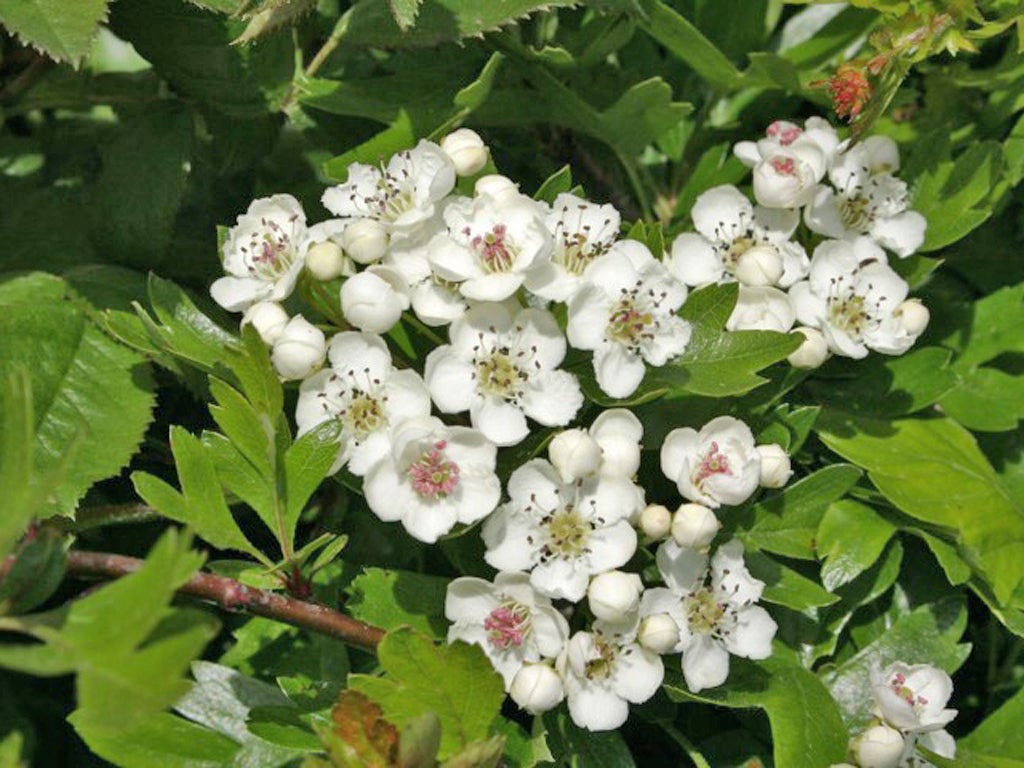Nature Studies by Michael McCarthy: If the blackthorn is sugar, then the hawthorn is cream
I grew up with a whacking great hawthorn hedge at the end of the garden

Here's a minor but welcome piece of news from the natural world: in the past week, in southern England anyway, the hawthorn has come into flower. The alternative name for its blooms, of course, is the May blossom – the Mayflower, the ship that took the pilgrim fathers to the New World in 1620, was named after it.
The blossoming of the May is one of the best things that happens in spring, for the look, and the smell, and the load of legends that cluster around it. You can see it best deep in the countryside, where hawthorn hedges form long field boundaries, because they are suddenly decorated in creamy white from end to end – when it's really spectacular, the hedges look as if they've been dressed for a wedding. The smell is sweet and hangs in the air.
It's interesting to compare it with the blossoming of its lesser-known, fellow spiky shrub, the blackthorn, which takes place between a month and two months earlier. This is white, too, but somehow it's an even whiter white (that sounds like a 1950s advertisement for soap powder...). There's a simple botanical reason for this: with the blackthorn, the flowers appear before the leaves, on the bare, black branches; with the hawthorn, it's the other way round.
So, with the May blossom, the flowers are mixed in with the iridescent young foliage which is already there, so that although if you're looking at a long hedge from a distance, the whiteness is indeed what you get first, from closer up, on a single tree, say, there's an effect of green-and-white, as if the whiteness were making you notice the green of the leaves for the first time.
It's an uncommon and arresting colour combination: in Britain, we have the hoops of Celtic FC and not much else in green-and-white, but it's a key colour mix in Arab countries.
With the blackthorn, on the other hand, the bare branches look as if they have been coated with hoar-frost after a freezing starry night, or dusted with sugar, in a white which is pure and crystalline. The smells reinforce this difference: both are sweet, but the blackthorn is cleanly sweet, whereas the hawthorn has another element which makes the scent thick and heady, almost a hint of rottenness in there somewhere. Think of it like this, perhaps: if the blackthorn is sugar, the hawthorn is cream.
I grew up with a whacking great hawthorn hedge at the end of our suburban garden, and I always loved its flowering, not least because the long evenings had come by then and the May blossom added something special to the dusk, seeming to glow dull-white through the gloaming. But lovely as it was, the family tradition held that it was unlucky to bring it into the house. My mother rationalised this by saying it was to keep insects out, but, of course, there are as many superstitions and legends about this tree as there are about rowan, some associating it with death.
The most famous one concerns Joseph of Arimathea, the man who looked after the burial of the crucified Jesus. The legend is that he came to Britain, bearing the Holy Grail – the cup used at the Last Supper – and at Glastonbury, he thrust his staff in to the ground and it changed into a hawthorn, which then, miraculously, proceeded to flower twice a year, in winter as well as in spring. You can still see such examples of the hawthorn sub-species biflora in the Glastonbury area, flowering in mid-winter. Make your own mind up about the legend. But it's certainly the case that hawthorn is a lot more than just a hedge.
Out of sight, and out of time
Many ducks are among our most familiar birds, from the omnipresent mallards and the tufted ducks of park lakes, to the wintering flocks of teal and wigeon in our wetlands. But sea ducks are a different matter.
These birds – such as the common and velvet scoters, the long-tailed duck, the scaup and the eider – spend much of their time riding the waves out of sight of land. Apart from the eider, they are barely known to most people, although tens of thousands of them winter off British coasts while breeding farther north.
Now comes news from the Wildfowl and Wetlands Trust that these species are in headlong decline around Europe: long-tailed duck populations appear to have dropped by up to 65 per cent in 15 years. The causes remain unknown, though the widespread nature of the declines has prompted concern that it is linked to environmental change across much of the arctic and sub-arctic regions where most of these species breed.
Most of us hardly know they're there; and now they're on the way out. The world keeps fraying at the edges.
Join our commenting forum
Join thought-provoking conversations, follow other Independent readers and see their replies
Comments